
K-141 Kursk was an Oscar II-class nuclear-powered cruise missile submarine of the Russian Navy. On 12 August 2000, K-141 Kursk was lost when it sank in the Barents Sea, killing all 118 personnel on board.

K-19 was the first submarine of the Project 658 class, the first generation of Soviet nuclear submarines equipped with nuclear ballistic missiles, specifically the R-13 SLBM. The boat was hastily built by the Soviets in response to United States' developments in nuclear submarines as part of the arms race. Before she was launched, 10 civilian workers and a sailor died due to accidents and fires. After K-19 was commissioned, the boat had multiple breakdowns and accidents, several of which threatened to sink the submarine.
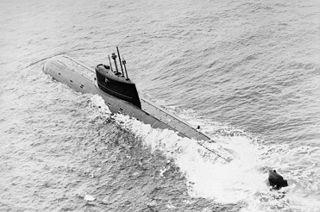
The K-278 Komsomolets was the Project-685 Plavnik, nuclear-powered attack submarine of the Soviet Navy; the only submarine of her design class.
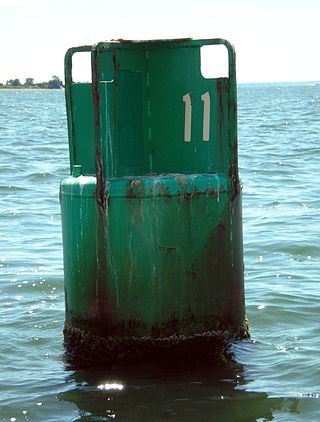
A buoy is a floating device that can have many purposes. It can be anchored (stationary) or allowed to drift with ocean currents.
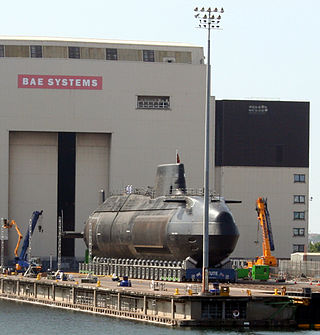
A nuclear submarine is a submarine powered by a nuclear reactor, but not necessarily nuclear-armed. Nuclear submarines have considerable performance advantages over "conventional" submarines. Nuclear propulsion, being completely independent of air, frees the submarine from the need to surface frequently, as is necessary for conventional submarines. The large amount of power generated by a nuclear reactor allows nuclear submarines to operate at high speed for long periods, and the long interval between refuelings grants a range virtually unlimited, making the only limits on voyage times being imposed by such factors as the need to restock food or other consumables.
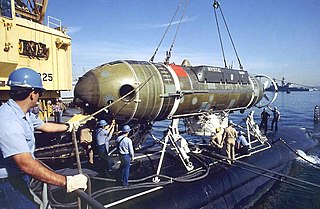
Mystic class is a class of Deep-Submergence Rescue Vehicles (DSRVs), designed for rescue operations on submerged, disabled submarines of the United States Navy or foreign navies. The two submarines of the class were never used for this purpose, and were replaced by the Submarine Rescue Diving Recompression System.

K-429 was a Project 670-A Скат nuclear submarine of the Soviet Navy. Her keel was laid down on 26 January 1971 at Krasnoye Sormovo in Gorky. She was launched on 22 April 1972, and was commissioned on 31 October 1972 into the Soviet Pacific Fleet.

The nuclear-powered Project 949A Antey submarine K-141 Kursk sank in an accident on 12 August 2000 in the Barents Sea. It was taking part in the first major Russian naval exercise in more than 10 years. All 118 personnel on board were killed. The crews of nearby ships felt an initial explosion and a second, much larger explosion, but the Russian Navy did not realise that an accident had occurred and did not initiate a search for the vessel for over six hours. The submarine's emergency rescue buoy had been intentionally disabled during an earlier mission and it took more than 16 hours to locate the submarine, which rested on the ocean floor at a depth of 108 metres (354 ft).

AS-28 is a Priz-class deep-submergence rescue vehicle of the Russian Navy, which entered service in 1986. It was designed for submarine rescue operations by the Lazurit Design Bureau in Nizhny Novgorod. It is 13.5 m (44 ft) long, 5.7 m (19 ft) high, and can operate up to a depth of 1,000 m (3,300 ft).
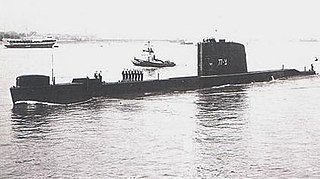
INS Dakar was a diesel–electric submarine in the Israeli Navy. The vessel, a modified World War II British T-class submarine, had previously been HMS Totem of the Royal Navy. She was purchased by Israel from the Government of the United Kingdom in 1965 as part of a three T-class submarine deal.
Project 210, Project 10831 or AS-31, nicknamed Losharik, is a Russian deep-diving nuclear powered submarine. On 1 July 2019, a fire broke out on the vessel while it was taking underwater measurements of the sea floor in Russian territorial waters.
Rear Admiral Oliver Francis Naquin, United States Navy was born in New Orleans, and was a 1925 graduate of the United States Naval Academy. He was one of 33 men rescued by the McCann Rescue Chamber when the submarine USS Squalus sank in 240 feet of water during routine sea trials in the Atlantic Ocean off Portsmouth, New Hampshire, on May 23, 1939, and was rescued in a two-day rescue operation.

The McCann Submarine Rescue Chamber is a device for rescuing submariners from a submarine that is unable to surface.

K-129 was a Project 629A diesel-electric-powered ballistic-missile submarine that served in the Pacific Fleet of the Soviet Navy–one of six Project 629 strategic ballistic-missile submarines assigned to the 15th Submarine Squadron based at Rybachiy Naval Base near Petropavlovsk, commanded by Rear Admiral Rudolf Golosov.

Prométhée (Q153) was a Redoutable-class submarine of the French Navy, launched in 1930 at Cherbourg. On 7 July 1932, while sailing on the surface during sea trials, she suddenly sank off Cape Lévi, Manche. 62 of her 69 crew were lost with her, causing an outpouring of grief in France. The wreck was located the following day, but attempts to rescue any survivors and refloat the vessel were in vain. Survivors' statements indicated that the sinking was likely due to a sudden opening of the diving purges.
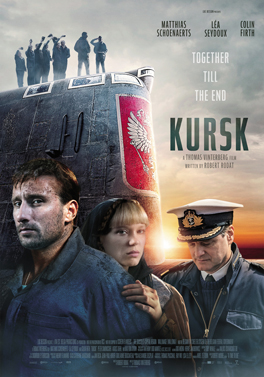
Kursk is a 2018 disaster drama-thriller film directed by Thomas Vinterberg, based on Robert Moore's book A Time to Die, about the true story of the 2000 Kursk submarine disaster. It stars Matthias Schoenaerts, Léa Seydoux, Peter Simonischek, August Diehl, Max von Sydow, and Colin Firth. It was the last film featuring von Sydow to be released before his death in March 2020.
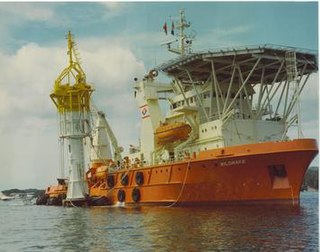
The Wildrake diving accident was an incident in Scotland in August 1979 that killed two American commercial divers. During a routine dive in the East Shetland Basin of the North Sea, the diving bell of the diving support vessel MS Wildrake became separated from its main lift wire at a depth of over 160 metres (520 ft). Although the bell was eventually recovered by Wildrake, its two occupants, 32-year-old Richard Arthur Walker and 28-year-old Victor Francis "Skip" Guiel Jr., died of hypothermia. The accident resulted in extensive subsequent litigation and led to important safety changes in the diving industry.
Ro-52, originally named Submarine No. 26, was an Imperial Japanese Navy Type L submarine of the L1 subclass. She was commissioned in 1920, sank accidentally in 1923 and again in 1925, was refloated and repaired each time, and was decommissioned in 1932.
Submarine rescue is the process of locating a sunk submarine with survivors on board, and bringing the survivors to safety. This may be done by recovering the vessel to the surface first, or by transferring the trapped personnel to a rescue bell or deep-submergence rescue vehicle to bring them to the surface. Submarine rescue may be done at pressures between ambient at depth, and sea level atmospheric pressure, depending on the condition of the distressed vessel and the equipment used for the rescue. Self-rescue of submarine personnel by buoyant free ascent at ambient pressure is considered submarine escape. Survivors may require recompression treatment for decompression illness.
















